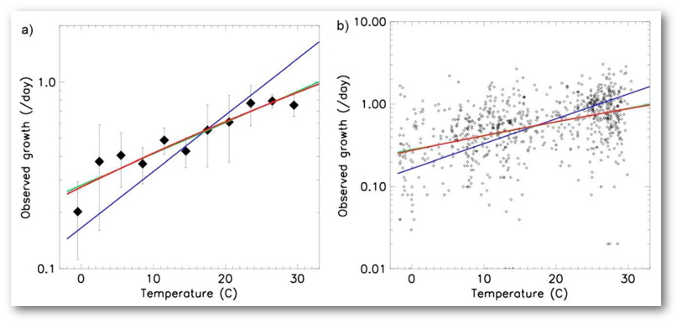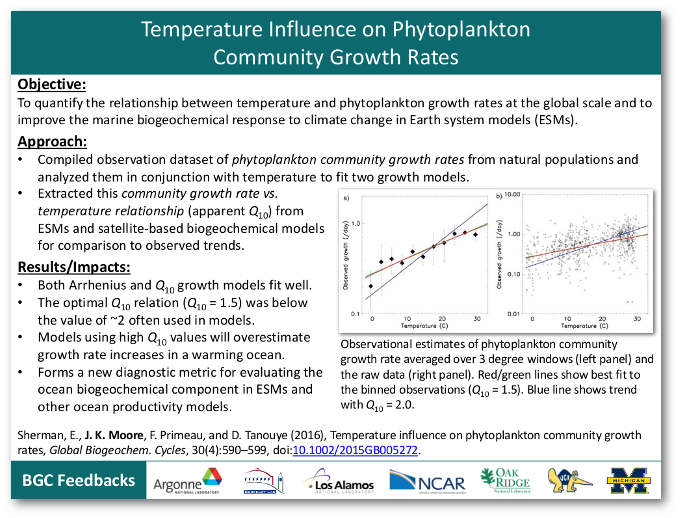Research Highlights
Temperature influence on phytoplankton community growth rates
April 5, 2016
The Science
Researchers at the University of California Irvine compiled an observational dataset of phytoplankton community growth rates from natural populations and analyzed them in conjunction with temperature to fit two growth models. They extracted this community growth rate vs. temperature relationship (apparent Q10) from ESMs and satellite-based biogeochemical models for comparison to observed trends. Both the Arrhenius and the Q10 growth models fit well. The optimal Q10 relation (Q10 = 1.5) was below the frequently used values of 2.0. Models using high Q10 values will overestimate growth rate increases in a warming ocean.
The Impact
Models using high Q10 values will overestimate growth rate increases in a warming ocean. This forms a new diagnostic metric for evaluating the ocean biogeochemical component in ESMs and other ocean productivity models.
Summary
A large database of field estimates of phytoplankton community growth rates in natural populations was compiled and analyzed to determine the apparent temperature effect on phytoplankton community growth rate. We conducted an ordinary least squares regression to optimize the parameters in two commonly used growth-temperature relations (Arrhenius and Q10 models). Both equations fit the observational data equally with the optimized parameter values. The optimum apparent Q10 value was 1.47 ± 0.08 (95% confidence interval, CI). Microzooplankton grazing rates closely matched the temperature trends for phytoplankton growth. This likely reflects a dynamic adjustment of biomass and grazing rates by the microzooplankton to match their available food source, illustrating tight coupling of phytoplankton growth and microzooplankton grazing rates. The field-measured temperature effect and growth rates were compared with estimates from the satellite Carbon-based Productivity Model (CbPM) and three Earth System Models (ESMs), with model output extracted at the same month and sampling locations as the observations. The optimized, apparent Q10 value calculated for the CbPM was 1.51, with overestimation of growth rates. The apparent Q10 value in the Community Earth System Model (V1.0) was 1.65, with modest underestimation of growth rates. The GFDL-ESM2M and GFDL-ESM2G models produced apparent Q10 values of 1.52 and 1.39, respectively. Models with an apparent Q10 that is significantly greater than ~1.5 will overestimate the phytoplankton community growth response to the ongoing climate warming and will have spatial biases in estimated growth rates for the current era.
Objective
To quantify the relationship between temperature and phytoplankton growth rates at the global scale and to improve the marine biogeochemical response to climate change in Earth system models (ESMs).
Approach
- Compiled observation dataset of phytoplankton community growth rates from natural populations and analyzed them in conjunction with temperature to fit two growth models.
- Extracted this community growth rate vs. temperature relationship (apparent Q10) from ESMs and satellite-based biogeochemical models for comparison to observed trends.
 |
Observational estimates of phytoplankton community growth rate averaged over 3 degree windows (left panel) and the raw data (right panel). Red/green lines show best fit to the binned observations (Q10 = 1.5). Blue line shows trend with Q10 = 2.0. |
Results/Impacts
- Both Arrhenius and Q10 growth models fit well.
- The optimal Q10 relation (Q10 = 1.5) was below the value of ~2 often used in models.
- Models using high Q10 values will overestimate growth rate increases in a warming ocean.
- Forms a new diagnostic metric for evaluating the ocean biogeochemical component in ESMs and other ocean productivity models.
Sherman, Elliot, J. Keith Moore, François Primeau, and David Tanouye. April 1, 2016. “Temperature Influence on Phytoplankton Community Growth Rates.” Global Biogeochem. Cycles, 30(4)550–559. doi:10.1002/2015GB005272.
